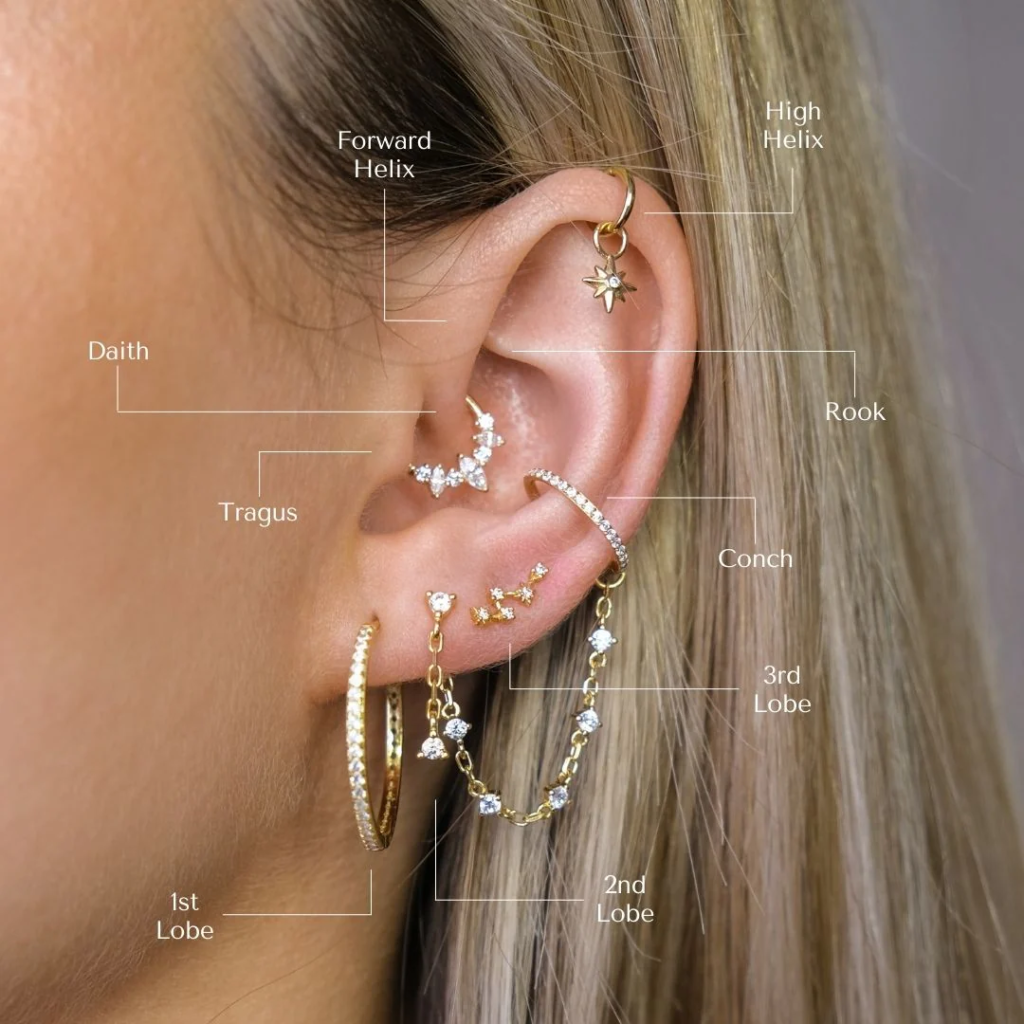Helix piercings have become a popular trend, celebrated for their ability to add a bold, stylish element to your look. However, before getting a helix piercing, it’s important to consider your unique ear anatomy, as this can influence the healing process, jewelry options, and overall comfort. Not all ear shapes are the same, and what works for one person may not work for another.
In this article, we’ll explore how your ear anatomy impacts the choice of helix piercing, the healing process, and what’s best for your ear shape. Whether you’re considering your first helix piercing or expanding your collection, understanding how your ear’s structure affects your piercing journey will help you make an informed decision.
What is a Helix Piercing
A helix piercing is a type of cartilage piercing that’s located on the upper part of the ear, specifically in the outer rim. It’s one of the most versatile ear piercings, and it can be customized in several ways, depending on the placement, number of piercings, and type of jewelry you choose.
Understanding Your Ear Anatomy

Before diving into the best practices for helix piercings, it’s important to understand the anatomy of your ear, as it can vary from person to person. The ear is made up of several parts:
Outer Rim (Helix): The upper outermost section of the ear, which is commonly pierced.
Forward Helix: The area closer to the head, just in front of the helix.
Conch: The inner cartilage of the ear, which may also be pierced in some cases.
Lobe: The soft, lower part of the ear that is typically pierced with simple earrings.
Your ear’s cartilage, particularly in the helix region, is what makes it a good candidate for this piercing. However, the shape and size of your ear will determine the most appropriate placement and type of jewelry.
How Your Ear Shape Affects Helix Piercing Placement
When it comes to helix piercings, your ear shape plays a significant role in determining the best location and style for your piercing. Let’s take a closer look at how different ear shapes affect helix piercings:
1. Small or Narrow Ears
If you have a smaller or narrower ear, there may be limited space on the helix for a piercing. In such cases, it’s important to work with a professional piercer who can assess your ear anatomy and help you choose an appropriate spot. You may also consider opting for a single helix piercing rather than multiple piercings.
Tip: A simple hoop or stud will likely look best, as larger jewelry may overwhelm a smaller ear.
2. Large or Proportionate Ears
For those with larger or more proportionate ears, you have more flexibility when it comes to helix piercing placement. You can easily opt for multiple piercings along the helix or even create a stacked look with double helix piercings.
Tip: A larger ear can handle multiple piercings, and the added space allows you to experiment with different types of jewelry, such as cuffs or clusters of small studs.
3. Curved or Floppy Ears
If your ear has a natural curve or some degree of “floppiness” near the helix, the jewelry may sit differently than on a straighter ear. In such cases, a professional piercer may recommend using small hoops or curved barbells that follow the natural curve of your ear, reducing discomfort and ensuring the jewelry stays in place.
Tip: Avoid overly tight rings or larger jewelry that may cause irritation due to the shape of your ear.
4. Prominent or Pointed Ears
If you have ears that stick out slightly from your head, a helix piercing can be especially striking, as it creates a beautiful contrast between the cartilage and the piercing. The visibility of the piercing will be more pronounced, so you may want to choose bold jewelry like large hoops or decorative studs to make a statement.
Tip: Consider a forward helix piercing or even a triple helix if you have a pronounced ear shape. These placements can create a cohesive and stylish look.
Choosing the Right Jewelry for Your Helix Piercing

The right jewelry can make a world of difference when it comes to your helix piercing. When considering your ear anatomy, think about the size and shape of your ear, as well as the level of comfort you need. Here are a few jewelry options to consider:
Studs: Ideal for smaller ears or those who prefer a minimalist look.
Hoops: Great for larger ears or when you want to add a touch of elegance.
Barbells: Can be used for forward helix piercings and offer a modern, clean look.
Cuffs: Perfect for creating a stacked look, particularly on larger ears.
Healing Process: How Ear Anatomy Affects Piercing Healing
Understanding how your ear shape influences healing is crucial, as cartilage piercings, including helix piercings, typically take longer to heal than lobe piercings. The healing process may be impacted by:
The Size of the Piercing: Larger piercings or multiple piercings along the helix may take longer to heal and require more aftercare.
Ear Shape: If your ear has a more curved or complex structure, it may be more prone to irritation, so extra care should be taken during healing.
Jewelry Type: Larger or heavier jewelry may cause more stress on the healing tissue, leading to longer healing times.
Generally, a helix piercing takes anywhere from 6 months to a year to fully heal, though pain, swelling, and irritation should subside within the first few weeks if cared for properly.
Aftercare Tips for Your Helix Piercing

Regardless of your ear shape, it’s essential to follow proper aftercare for your helix piercing to avoid complications. Here are some aftercare tips:
Clean the area with saline solution twice daily.
Avoid touching the piercing with dirty hands.
Be mindful of sleeping positions—use a soft pillow or avoid sleeping on the side of the piercing until it’s fully healed.
Avoid swimming in pools, hot tubs, or bodies of water until the piercing has fully healed.
Conclusion
A helix piercing can be an excellent choice for enhancing your style, but understanding how your unique ear anatomy influences the piercing process is key. Whether you have small ears, large ears, or a specific ear shape, working with an experienced piercer and choosing the right jewelry and placement will ensure that your helix piercing looks great and heals properly.
(FAQs)
1. Can I get a helix piercing if I have small ears?
Yes, but it’s important to discuss with your piercer the best placement for your ear size. A single helix piercing is usually ideal for smaller ears.
2. Does a helix piercing hurt more than a lobe piercing?
Helix piercings typically hurt more than lobe piercings due to the thicker cartilage in the upper ear. However, pain levels vary from person to person.
3. Can I get multiple helix piercings at once?
Yes, if your ear anatomy allows, you can get multiple helix piercings. Just be sure to consult a professional piercer who can assess your ear’s space and design the best layout for you.
4. How long does it take for a helix piercing to heal?
Healing time for a helix piercing typically ranges from 6 months to 1 year, depending on factors such as jewelry choice and aftercare.
5. Will a helix piercing look good on my ear shape?
This depends on your ear shape. People with larger ears have more flexibility for multiple piercings, while smaller ears may benefit from a single, carefully placed piercing.
Read Next: Jailyne Ojeda Net Worth: How She Turned Social Media Fame Into Fortune

















































































